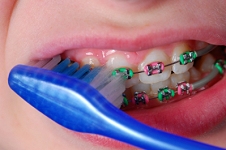Frequently Asked Questions
What is Orthodontics?
Orthodontics is a specialist field of dentistry concerned with the study and treatment of improper bites. These may arise from tooth irregularity and or a disproportional jaw relationship. Orthodontic treatment can not only straighten crooked teeth but also control and modify facial growth, i.e. shorten or lengthen the jaws which may be done within an orthodontic practice or further surgery may be required.
Why have Orthodontic Treatment?
There are 4 main reasons for orthodontics
1. For most people orthodontic treatment is chosen to improve cosmetic appearance, and with that self-confidence and esteem. Smiling alone can make you happy and a nice smile can have powerful effects on others.
2. To correct the bite. Such examples would be if the lower teeth bump into the roof of the mouth causing pain or excess wear on some teeth. Or if food gets lodged constantly between teeth this can cause gum disease and decay from an inability to clean the teeth properly.
3. To aid proper speech. Gaps between teeth or jaw misalignment may lead to difficulties pronouncing words. Correcting these problems may lead to being better understood.
The Train And Its Tracks
 Braces are made up from 2 main components 1. Brackets which are stuck or bonded on to the teeth, and serve to hold the wires in place. 2. Archwires or wires (tracks) that slot through the brackets and exert their force on the teeth by gently pulling them into the required position. There is very little wire bending these days in orthodontics since the discovery that wires have ‘memory’ and always try to go back to their original arched position, hence these clever wires do a lot of the work themselves. Other shorter wires may need to be added and manipulated at various stages of treatment to get the correct finish.
Braces are made up from 2 main components 1. Brackets which are stuck or bonded on to the teeth, and serve to hold the wires in place. 2. Archwires or wires (tracks) that slot through the brackets and exert their force on the teeth by gently pulling them into the required position. There is very little wire bending these days in orthodontics since the discovery that wires have ‘memory’ and always try to go back to their original arched position, hence these clever wires do a lot of the work themselves. Other shorter wires may need to be added and manipulated at various stages of treatment to get the correct finish.
Click here for more information on Train Track Braces
Click here to pick your colour elastics
Suitability For Orthodontics
Most people are suitable for orthodontic therapy. It is very important to have clean and healthy teeth and gums before and during orthodontic treatment.
Extraction Or Non-Extraction Of Teeth
Nobody wants to have teeth taken out and at Park Orthodontics we endeavor to leave them in. American orthodontists generally don’t extract and this leads to a wider bigger smile which may not suit everyone. Dr Alcock, looks at the wider picture; the age of patient and if there is much jaw development left; the condition of the teeth, if there’s alot of decay they may be best extracted; the shape of the face and jaw; sex of patient (men suit a bigger jaw). Then in consultation with the patient and what they want it can be decided what will work best. Extractions can always be done during the course of treatment as movement is assessed.
Time Frame For Treatment
Treatment with removable appliances usually take 9-12 months. However removable appliances can only be used to treat minor problems. Treatment with fixed braces, which are more commonly referred to as “traintrack” braces, Invisalign and Incognitio braces usually take between 12 to 18 months. Some orthodontists charge extra when treatment takes longer than estimated, we think this is unfair so our price is fixed at the start of treatment.
Best Age To Be Seen
 The Orthodontic Society Of Ireland recommends patients to be seen at between 7 to 8 years of age. At this early age all that may be needed is just a short course of treatment to improve a smile and avoid more complex and expensive treatment in the future. Dr Alcock may decide that no or only minor treatment is required.
The Orthodontic Society Of Ireland recommends patients to be seen at between 7 to 8 years of age. At this early age all that may be needed is just a short course of treatment to improve a smile and avoid more complex and expensive treatment in the future. Dr Alcock may decide that no or only minor treatment is required.
Mostly our patients begin treatment in their teenage years.
30% of our patients are adults, with some grandparents receiving orthodontic treatment and feeling great because of it.
